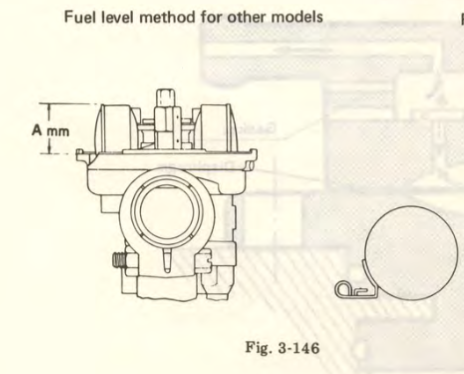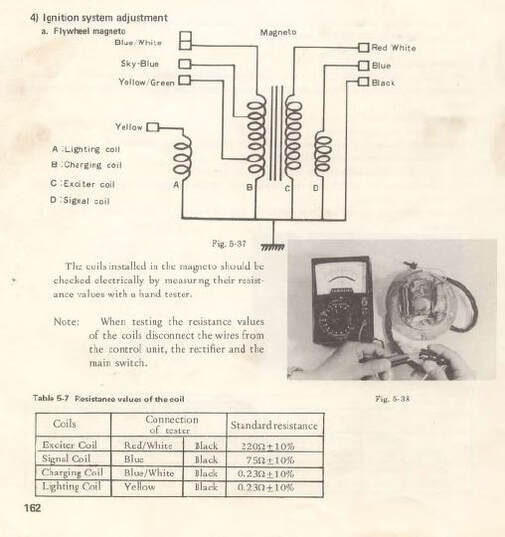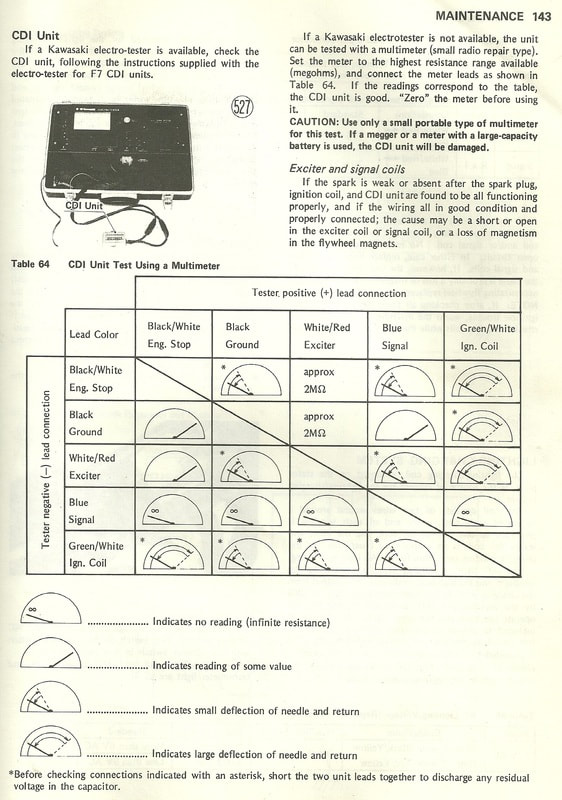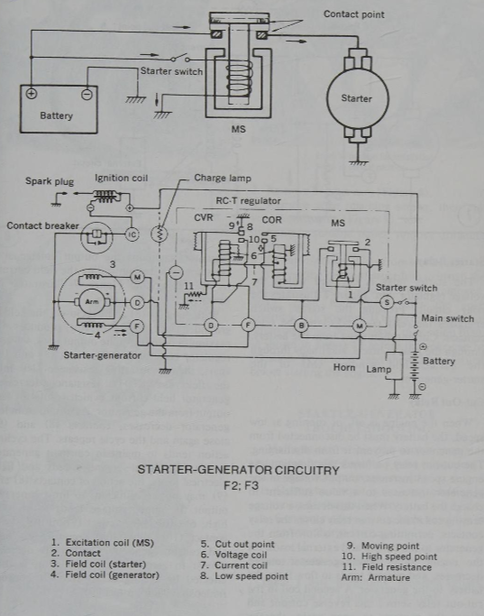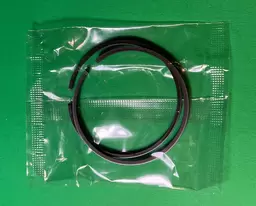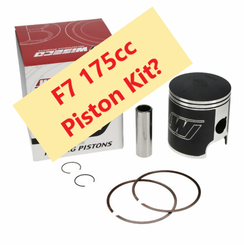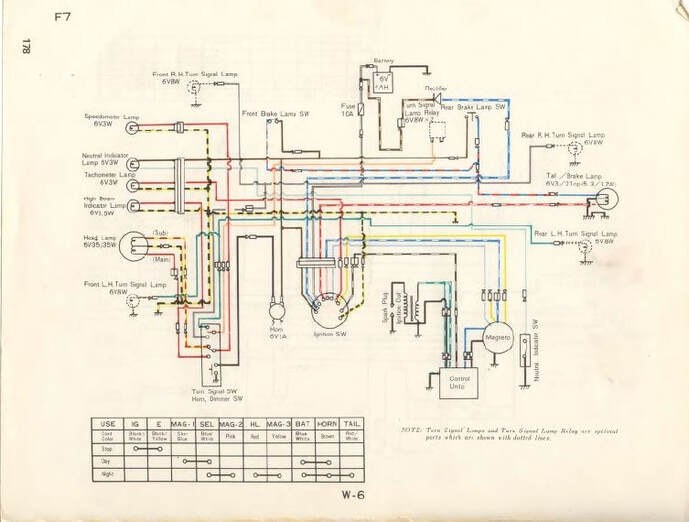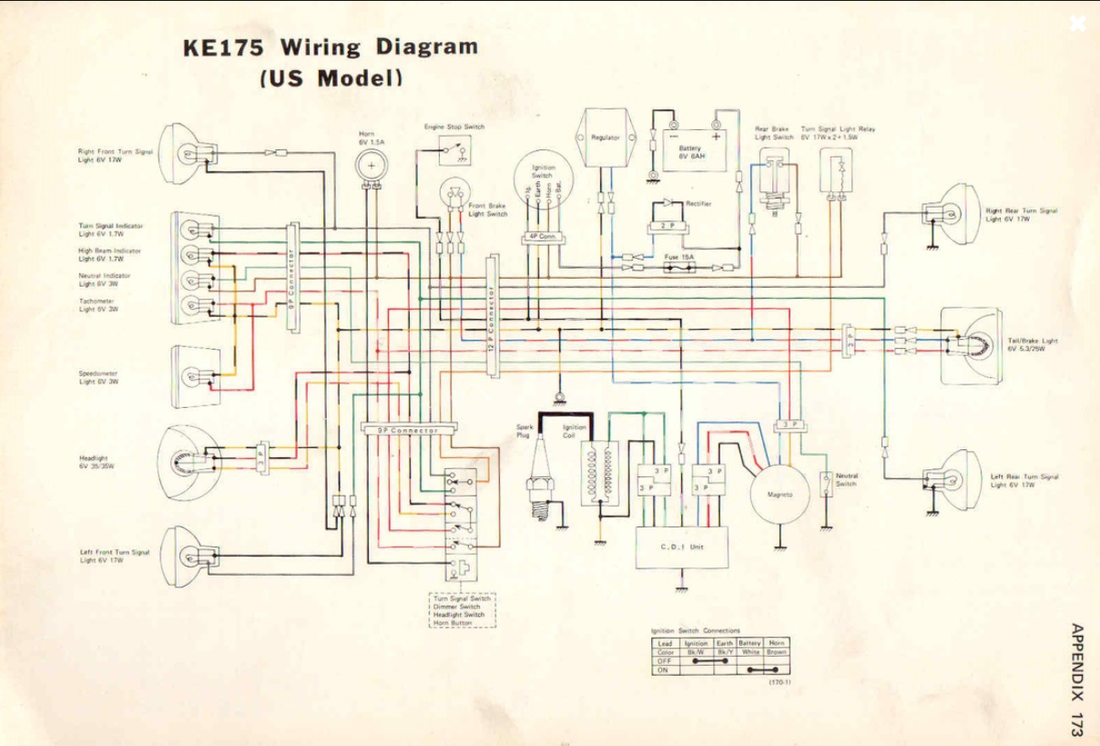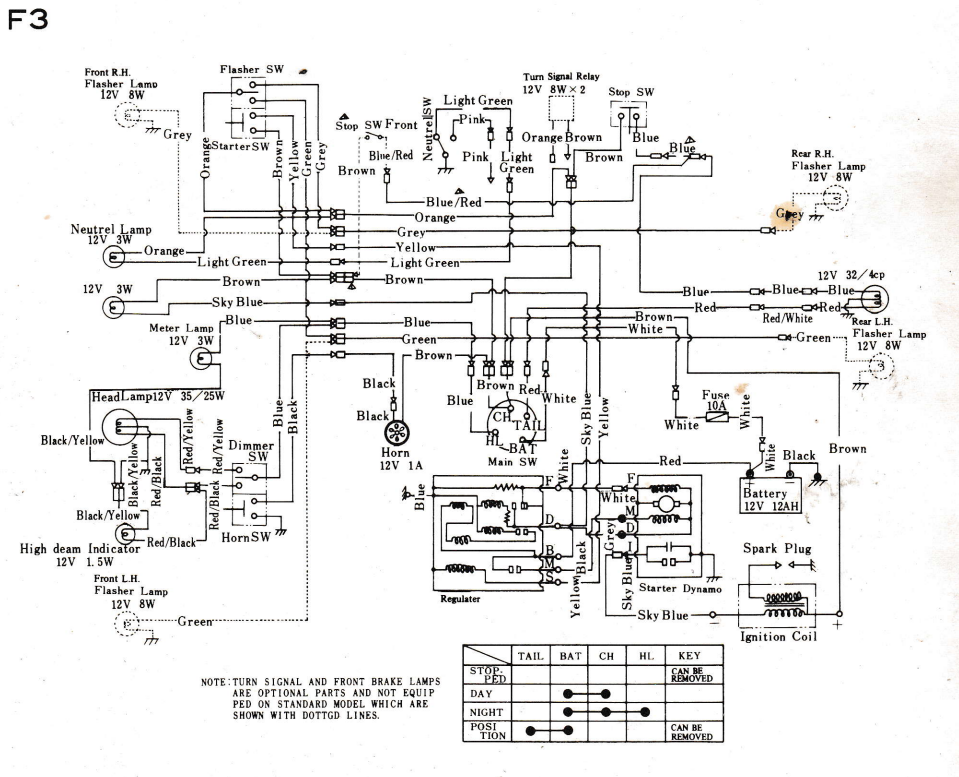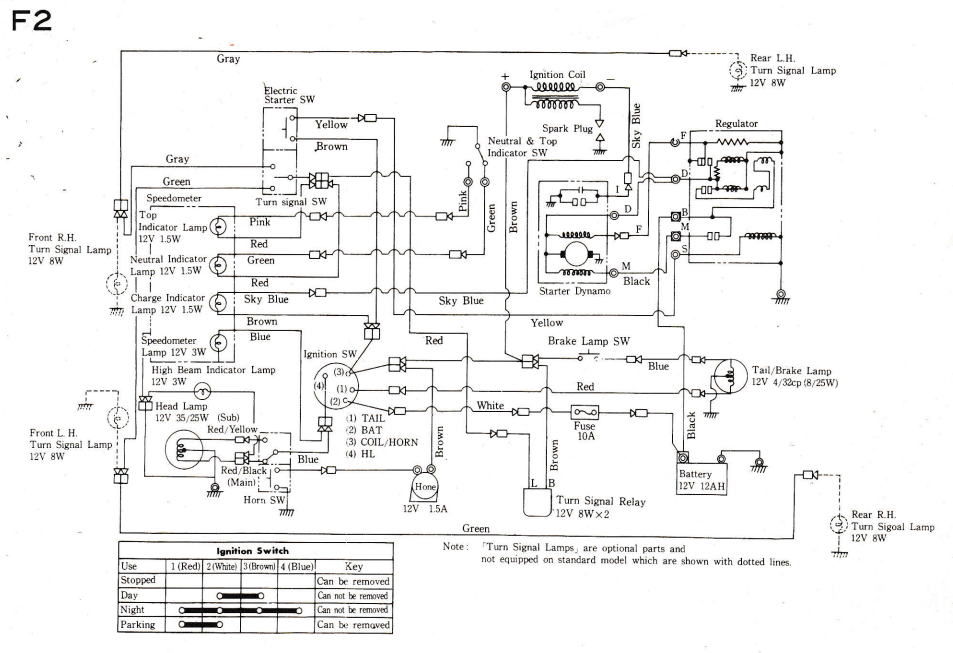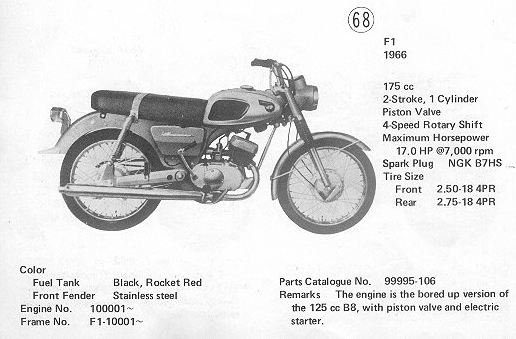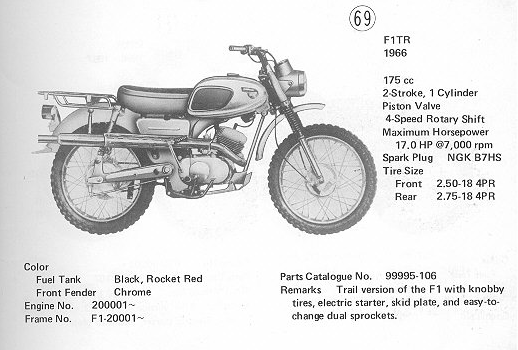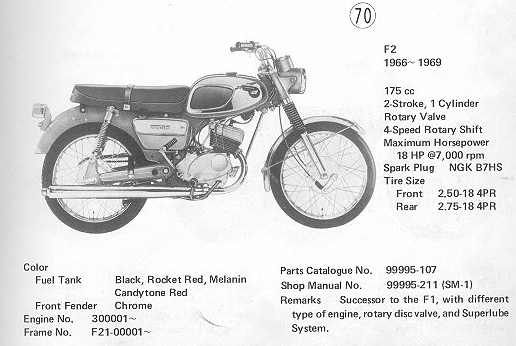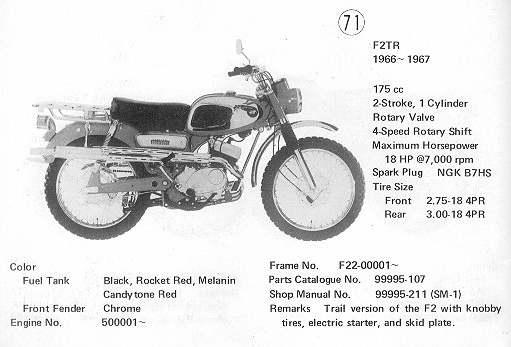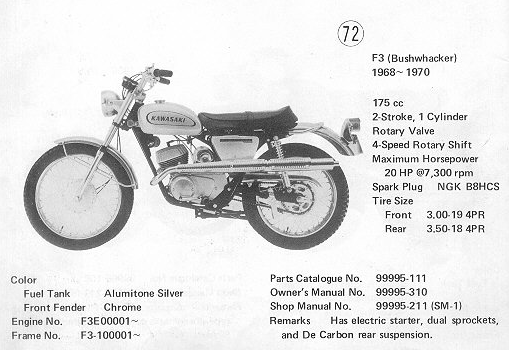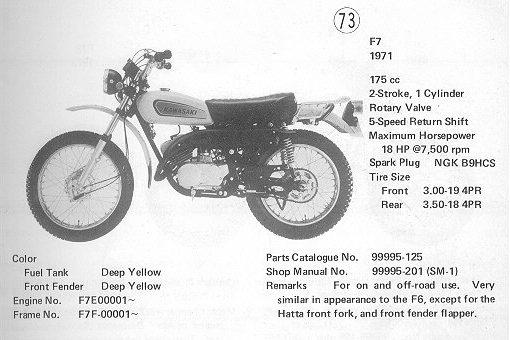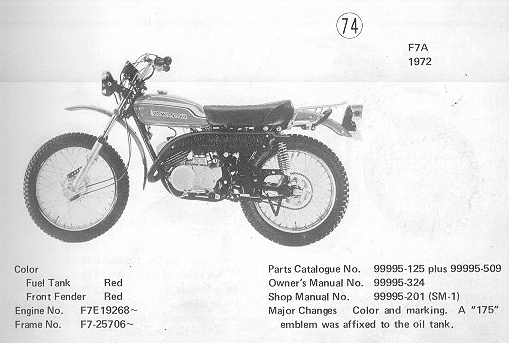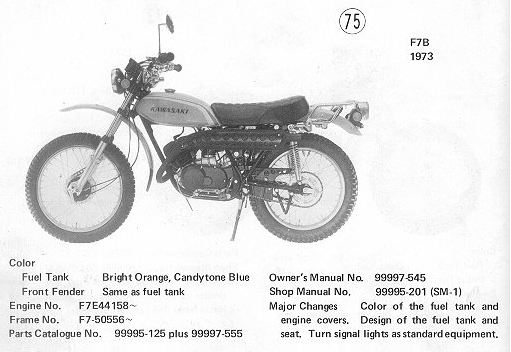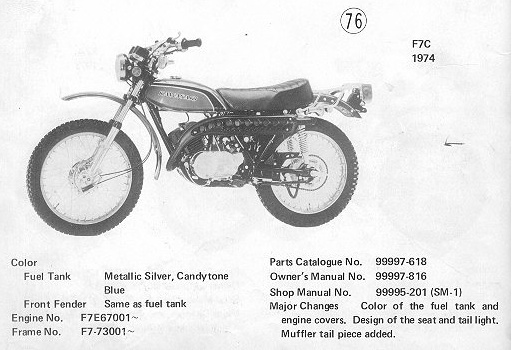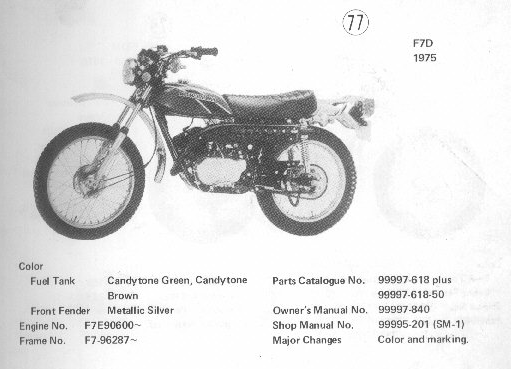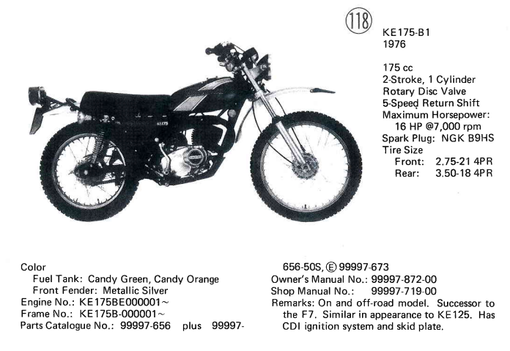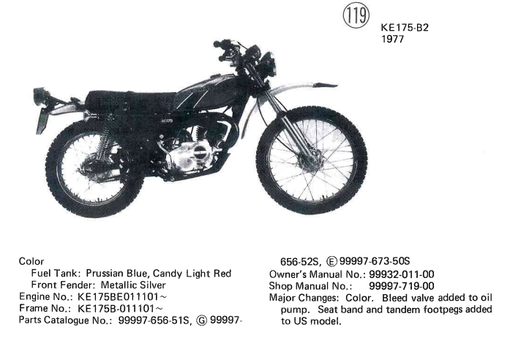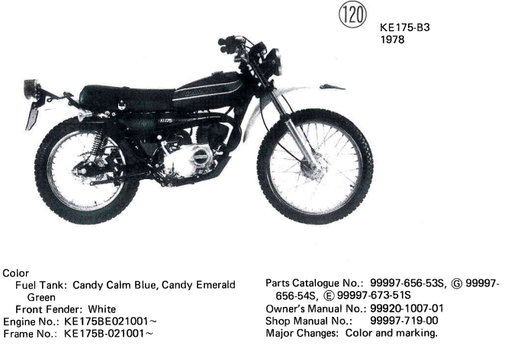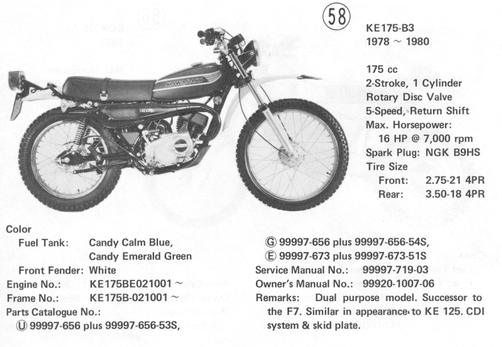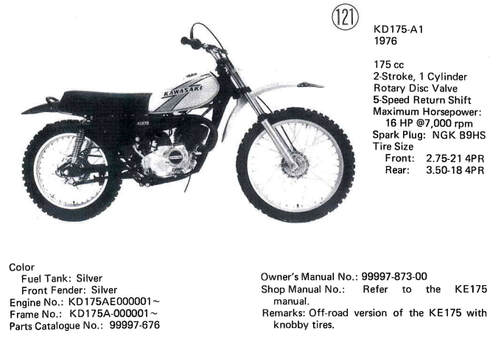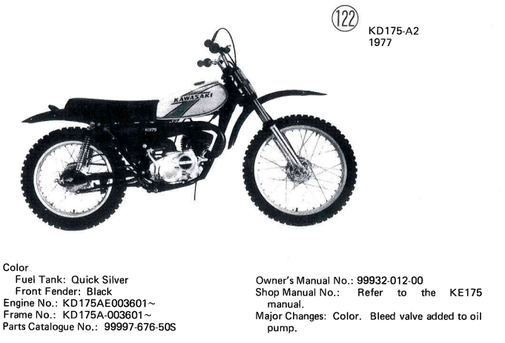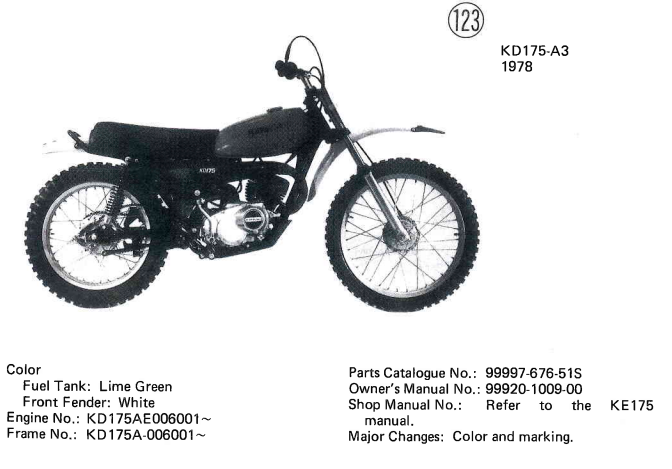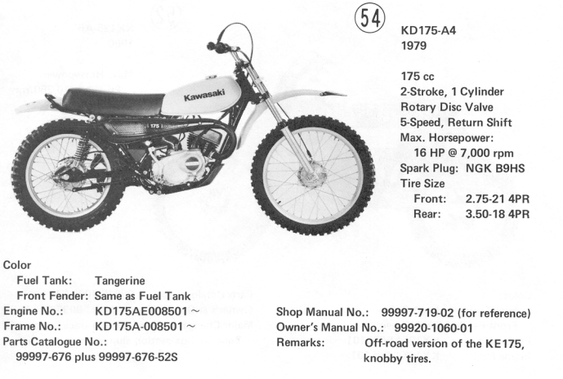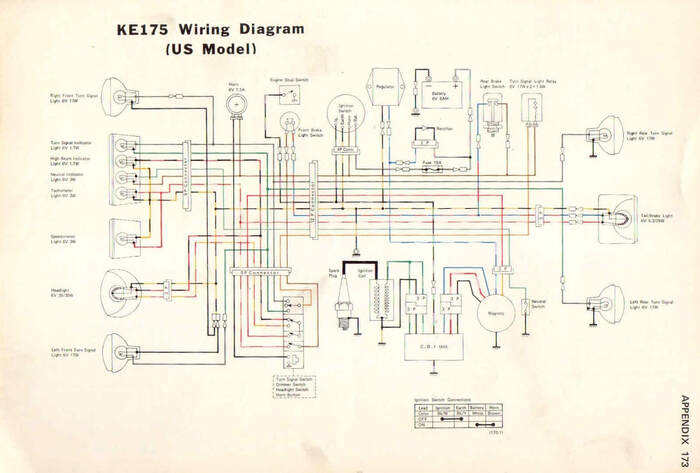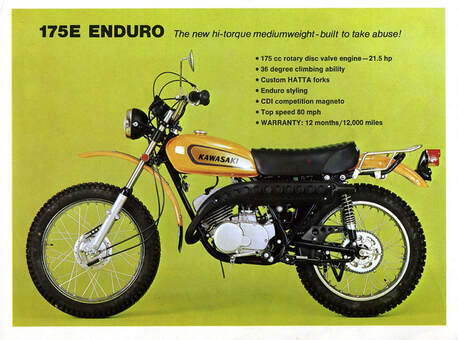 Kawasaki F7 175
Kawasaki F7 175
175 CC
F2, F2TR, F3 (Bushwacker), F7, KE175, KD175
F1, F1TR (piston port models)
Probably the most recognized and well known of the 175's is the F7, however a few models preceded it paving the way for the F7's (claimed) 21 hp. Unlike some of the other smaller displacements the F7 shares very little with the previous models. It could be considered that the F7 is a highly refined and more developed version of the F3 even thought they share almost nothing. The KE175 is a lower horsepower version of the F7 it shares a few things like the crankshaft and connecting rod assembly, but the pistons are different.
Read here about the "drain pump" on the front of the crankcase that can fail causing jetting problems and even piston seizure. Applies to the F7 & KD175/KE175.
Interesting facts about the first 175cc machines (F1, F2, F3) all featured electric starting as well as a kick starter. Details below about how the generator, for powering the lights and charging, was also used as a starter motor to get the bike running. Slightly complicated, but a unique feature that other bikes didn't have at the time.
Kawasaki 175cc models frame & engine identification (below)
The frame and engine numbers indicate the beginning of the sequence for that model year. The next model year starts the sequence after the previous model years number.
*it is common for frame and engine numbers to mis-match within a given year
F2, F2TR, F3 (Bushwacker), F7, KE175, KD175
F1, F1TR (piston port models)
Probably the most recognized and well known of the 175's is the F7, however a few models preceded it paving the way for the F7's (claimed) 21 hp. Unlike some of the other smaller displacements the F7 shares very little with the previous models. It could be considered that the F7 is a highly refined and more developed version of the F3 even thought they share almost nothing. The KE175 is a lower horsepower version of the F7 it shares a few things like the crankshaft and connecting rod assembly, but the pistons are different.
Read here about the "drain pump" on the front of the crankcase that can fail causing jetting problems and even piston seizure. Applies to the F7 & KD175/KE175.
Interesting facts about the first 175cc machines (F1, F2, F3) all featured electric starting as well as a kick starter. Details below about how the generator, for powering the lights and charging, was also used as a starter motor to get the bike running. Slightly complicated, but a unique feature that other bikes didn't have at the time.
Kawasaki 175cc models frame & engine identification (below)
The frame and engine numbers indicate the beginning of the sequence for that model year. The next model year starts the sequence after the previous model years number.
*it is common for frame and engine numbers to mis-match within a given year
|
F7 Carburetor Settings
Type- VM26SC (26mm) Main Jet - 105 "R" (round head) Needle Jet - 0-2 Jet Needle - 4EJ 3-34Et 3-3 Pilot Jet - 30 Cutaway - 2.5 Air screw - 1-1/2 turns out Float height (measurement A): 26.5mm +/- 1mm F3 Carburetor Settings Type- VM26SC (26mm) Main Jet - 190 (hex) Needle Jet - N-6 Jet Needle - 4J13-34Et 3-3 Pilot Jet - 45 Cutaway - 2.0 Air screw - 1-3/4 turns out Float height (measurement A): 26.5mm +/- 1mm F2 Carburetor Settings Type- VM22SC (22mm) Main Jet - 200 (hex) Needle Jet - N-8 Jet Needle - 4J13-24Et 3-3 Pilot Jet - 30 Cutaway - 2.0 Air screw - 1-3/4 turns out Float height (measurement A): 25.7mm +/- 1mm |
Kawasaki F7 carburetors are different through the years. The 71-73 F7 used a clamp on style carburetor with a plastic inner ring that clamped directly on the rotary valve inlet. The later 74-74 used a carburetor without a clamp and is held on via a rubber boot that is bolted to the right side engine cover. Both styles of carburetors used brass floats that were situated laterally to the frame of the bike. A later replacement carburetor that also came standard on the KE/KD/KS175 bikes had a plastic float with its pivot arm longitudinally with the bikes frame. The latter is preferred for performance reasons as the float level will stay more consistent when the bike is in motion. This later KE175 carburetor used the later F7 style with no built in clamp.
Piston compatibility: Common question "Can I use a KE175 piston in an F7?" and vice versa. Short answer is NO. The pistons are very similar but the piston pin is in a different location which is the reason for the lower compression and different exhaust port timing on the KE175 and the lower power output rating.
Incidentally the F1 (piston port), F2 & F3 have pistons unique to their respective models and are not compatible with each other or the later F7 & KE175 (B-series). Also not to be confused with the later (post 1980) KE175 D-series that is a piston/reed engine which is entirely different than the pre-1979 KE175 rotary valve B-Series. Aftermarket F7 replacement rings!! From Disaster Motors Kawasaki F7 175 Piston Ring Set STD. # 1971 1972 1973 1974 1975 13008-027 (Rumor, needs validation) Looking for a replacement piston for the F7? What pistons fit the F7? Essentially a 0.060 oversized piston for a H1/KH500 triple is suitable.
Vintco SKU# PSK01-1.5 (Designed for H1/KH500 61.5mm, 1.5mm oversize, kit) Wiseco SKU# 149M6150 (Designed for H1/KH500 61.5mm bore, kit) Vintco SKU# BNW004 (Wrist pin bearing for above kit) *Wrist pin bearing is not included with either of these options. However OEM bearings usually fit aftermarket wrist pins by application and are more readily available.* |
175cc model identification
|
F1 1966
*single year model, not a rotary valve engine Engine No. 100001- Frame No. F1-10001- 2 stroke Oiling System: Super-Lube Ignition: Contact Breaker Point Gap: 0.03mm~0.4mm Transmission oil: SAE 10W30 or ATF Piston port engine. Also features an electric starter, a unique feature for the time. Sold along side the F2 and can be easily confused in identification especially if engine is removed. |
|
F1TR 1966
*single year model, Not a rotary valve engine Engine No. 200001- Frame No. F1-20001- 2 stroke Oiling System: Super-Lube Ignition: Contact Breaker Point Gap: 0.03mm~0.4mm Transmission oil: SAE 10W30 or ATF Piston port engine. Trail version of the F1 with upswept pipe, luggage rack and knobby tires. Also features electric starter, a unique feature for the time. Sold along side the F2 and can be easily confused in identification especially if engine is removed. |
|
F2 1966-1969
*sequence is not broken out by model year Engine No. 300001- Frame No. F21-00001- 2 stroke Oiling System: Super-Lube Ignition: Contact Breaker Point Gap: 0.03mm~0.4mm Transmission oil: SAE 10W30 or ATF Evolution of the F1. First year for the 175cc rotary valve engine. Updated rear shocks. Can be confused with the F1 especially if the engine is removed. |
|
F2TR 1966-1967
*sequence is not broken out by model year, trail version of the F2 Engine No. 500001- Frame No. F22-00001- 2 stroke Oiling System: Super-Lube Ignition: Contact Breaker Point Gap: 0.03mm~0.4mm Transmission oil: SAE 10W30 or ATF Trail version of the F2 with upswept pipe, luggage rack and knobby tires. Evolution of the F1TR. First year for the 175cc rotary valve engine. Updated rear shocks. Can be confused with the F1TR especially if the engine is removed. |
|
F3 Bushwhacker 1968-1970
*sequence is not broken out by model year Engine No. F3E00001- Frame No. F3-100001- Street scrambler styling with upswept pipe. Minor engine performance upgrades over the F2 going from 18 horsepower to 20. Improved suspension over previous models. Retains the electric starter from the F2. For 1969-1970 dual overlay (59 tooth & 44 tooth) rear sprockets for gearing changes were standard. (all years use 428 chain) (1968) 38T sprocket - 114 link (1969-1970) 44T sprocket - 118 link 59T sprocket - 126 link 2 stroke Oiling System: Super-Lube Ignition: Contact Breaker Point Gap: 0.03mm~0.4mm Transmission oil: SAE 10W30 or ATF |
|
F7 1971
*new model, "enduro" styling Engine No. F7E00001- Frame No. F7F-00001- The legend of the 175cc class. Shares almost nothing with the previous F3. Enduro styling. 5 speed return shift. One of only 3 models to feature the HATTA forks with adjustable axle positioning. Also included CDI ignition identical to the F5/F9, a rare feature for this era. 2 stroke Oiling System: Super-Lube Ignition: CDI (see wiring & tests below) Transmission oil: SAE 10W30 or ATF |
|
F7 A 1972
*styling updates Engine No. F7E 19268- Frame No. F7-25706- 2 stroke Oiling System: Super-Lube Ignition: CDI (see wiring & tests below) Transmission oil: SAE 10W30 or ATF |
|
F7 B 1973
*styling updates Engine No. F7E44158- Frame No. F7-50556- Different fuel tank shape. Turn signals are standard. Engine covers, cylinder & head painted black for heat dissipation. 2 stroke Oiling System: Super-Lube Ignition: CDI (see wiring & tests below) Transmission oil: SAE 10W30 or ATF |
|
F7 C 1974
*styling update Engine No. F7E67001- Frame No. F7-73001- Redesigned seat and tail light assembly. 2 stroke Oiling System: Super-Lube Ignition: CDI (see wiring & tests below) Transmission oil: SAE 10W30 or ATF |
|
F7 D 1975
*Styling update Engine No. F7E90600- Frame No. F7-96287- No significant updates. Last production year for the F7. 2 stroke Oiling System: Super-Lube Ignition: CDI (see wiring & tests below) Transmission oil: SAE 10W30 or ATF |
|
KE175 B1 1976
*new model, shares little with the F7 Engine No. KE175BE000001 - Frame No. KE175B-000001- New model for 1976. Engine specifications changed and shares very little with the previous F7. Horsepower went down from 18 to 16, but is a more broad power. More resilient plastic fenders used. Big brother to the KE125. Ignition: CDI (see wiring & tests below) *not compatible with the F7 Transmission oil: SAE 10W30 or ATF |
|
KE175 B4 & B5 1979-1980
*same as 1978 model 1980 is the last year for the rotary valve 175cc. 1980 KE175 D1 introduced a reed valve piston port engine that a version of it would make its way into the KDX175 later. Also the piston reed KE175 D-series would be the basis for the KV175 "agi" bikes designed for farm & ranch work in the Australian market. |

